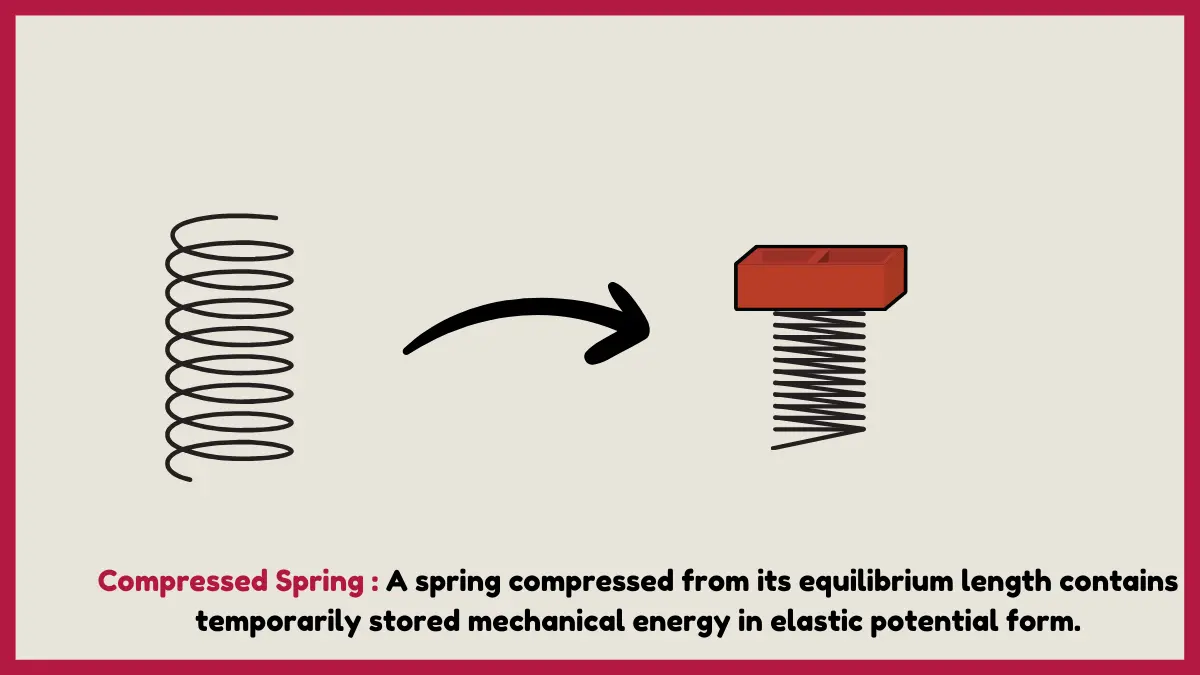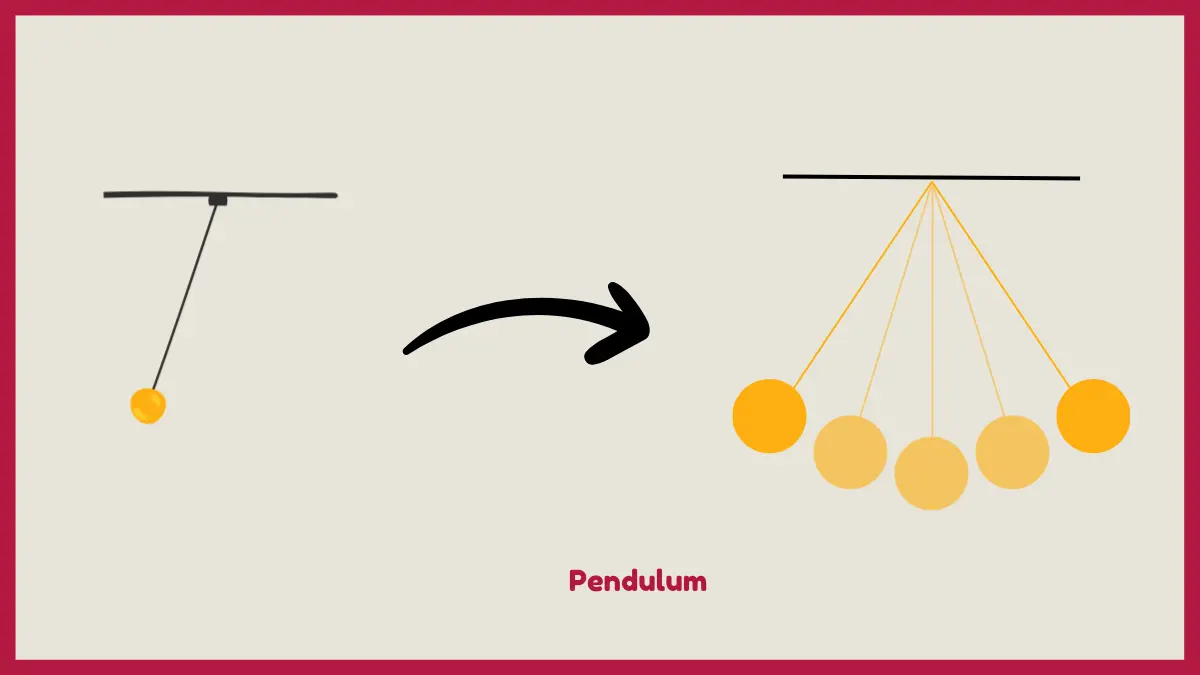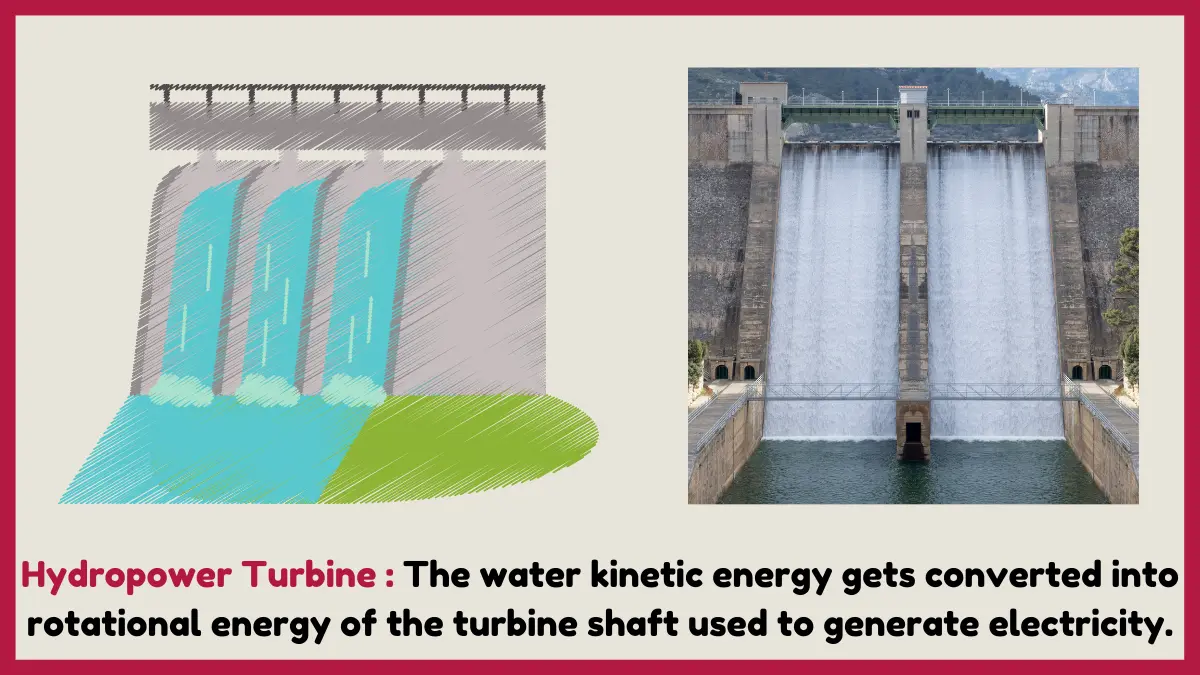Mechanical energy is exemplified by the stretched elastic band’s recoil, the compressed spring’s expansion, the pendulum’s swing, the bicycle wheel’s rotation, the falling book’s acceleration, the arrow’s propulsion, the gear train’s motion, the turbine’s spin, the windmill’s rotation, and the bouncing ball’s repetitive energy conversions.
Examples of Mechanical Energy
Here are 10 examples of mechanical energy with experiments:
1. Stretched Elastic Band
An elastic band stretched to expand its length stores mechanical energy in the form of elastic potential energy. As polymer chains in the band are extended, they exert restoring forces proportional to the deformation, which can do work.

Experiment: Stretch an elastic band between your fingers then allow it to snap back into place. The rapid contraction signifies the stored elastic potential energy being converted into kinetic energy.
2. Compressed Spring
A spring compressed from its equilibrium length contains temporarily stored mechanical energy in elastic potential form. Compression produces opposing restore forces proportional to the displacement.

Experiment: Place a heavy book atop a coiled spring, compressing it, then suddenly remove the book allowing the spring to expand again. The expanding motion reflects the elastic potential energy transforming into kinetic energy.
3. Pendulum
A pendulum consists of a weight suspended from a pivot so it can swing freely back and forth. At the maximum heights of its swing, it momentarily stops as all energy becomes gravitational potential energy stored due to the elevation. At the lowest point, its kinetic energy is highest.

Experiment: Lift a pendulum weight to one side and allow it to swing back down. Its acceleration as it descends shows gravitational potential energy converting to kinetic energy.
4. Bicycle Wheel
As a bicycle wheel turns, rotational kinetic energy builds up associated with spinning motion. The faster the wheel spins, the greater its stored circular kinetic energy. This energy drives continual wheel rotation once established by pedal input force.

Experiment: Pedal a bike to get the front wheel spinning rapidly, then observe how long the wheel continues rotating after stopping the pedal input. This illustrates the built up rotational kinetic energy.
5. Book on Table
A book at rest on a tabletop has gravitational potential energy relative to the floor due to its elevated position. If pushed off the edge, the book’s potential energy converts into kinetic energy as it accelerates downward to the floor.

Experiment: Hold a book over the edge of a table, then allow it to drop, watching acceleration build up as it falls. Its gravitational potential energy transforms into increasing kinetic energy during descent.
6. Arrow Shot From Bow
An arrow gets potential energy as the bowstring becomes drawn back. Once released, the string’s contraction imparts kinetic energy into the arrow sending it flying at rapid velocity. Aerodynamic drag then gradually depletes this directed kinetic energy.

Experiment: Use a toy bow and arrow set or handmade versions to witness the string elastic potential energy transform into arrow kinetic energy the moment the shaft is loosed.
7. Falling Weight and Gear Train
A free weight falling from height has gravitational potential energy that can transfer into horizontal motion through a pulley driving a gear train. This achieves useful directional power transmission.

Experiment: Affix a small falling weight by pulley to turn several interlocking gear wheels. The gravitational potential energy becomes horizontal rotor spinning activity.
8. Hydropower Turbine
Flowing water carries kinetic energy that spins hydroturbine blades oriented perpendicular to the flow direction. The water kinetic energy gets converted into rotational energy of the turbine shaft used to generate electricity.

Experiment: Direct a stream of running water from a faucet or open hose onto angled fan blades to make them spin. This illustrates kinetic to rotational energy transfer.
9. Windmill Rotors
Wind pushing against the angled sails of a windmill contains measurable kinetic energy that gets transferred into spinning rotor motion, creating electricity through generators and dynamos.

Experiment: Mount a small pinwheel or vane onto a stick and observe it begin passively spinning when exposed to a gentle breeze, turning wind kinetic energy into rotational kinetic energy.
10. Bouncing Ball
A bouncing ball has gravitational potential energy proportional to how high it gets elevated after each bounce. At peak height, this potential energy momentarily transforms back into temporary kinetic energy driving it downward again.

Experiment: Drop a rubber ball to watch repetitive bounces become conversions between gravitational potential energy at maximum heights and kinetic energy while falling.

